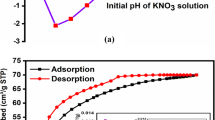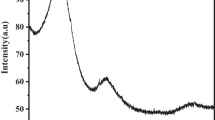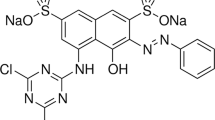Abstract
The discharge of dye-containing industrial effluents such as methylene blue (MB) in water bodies has resulted in severe aquatic and human life problems. In addition to this factor, there is the accumulation of banana peel wastes, which can generate ecological damage. Thus, this research purpose a different method from the literature using the banana peel waste (BP) to produce activated carbon (ACBP) by NaOH activation followed by pyrolysis at 400 °C to remove methylene blue (MB). The material was characterized by TGA, XRD, SEM, BET, and FTIR. The influence of dye concentration (10, 25, 50, 100, 250, and 500 mg L−1) was investigated. ACBP presented a well-developed pore structure with a predominance of mesopores and macropores. This morphological structure directly influences the MB removal capacity. The highest efficiency for dye removal was in the MB initial concentration of 25 mg L−1, sorbent of 0.03 g, and contact time of 60 min, which were 99.8%. The adsorption isotherms were well defined by Langmuir, Freundlich, and Temkin isotherm models. The Langmuir model represented the best fit of experimental data for ACBP with a maximum adsorption capacity of 232.5 mg g−1. This adsorbent showed a comparatively high performance to some previous works. So, the banana peel waste is an efficient resource for producing activated carbon and the adsorption of methylene blue.








Similar content being viewed by others
References
Gautam RK, Mudhoo A, Lofrano G, Chattopadhyaya MC (2014) Biomass–derived biosorbents for metal ions sequestration: adsorbent modification and activation methods and adsorbent regeneration. J Environ Chem Eng 2:239–259. https://doi.org/10.1016/j.jece.2013.12.019
Mpatani FM, Aryee AA, Kani AN, Wen K, Dovi E, Qu L, Li Z, Han R (2020) Removal of methylene blue from aqueous medium by citrate modified bagasse: kinetic, equilibrium and thermodynamic study. Bioresour Technol Rep 11:100463. https://doi.org/10.1016/j.biteb.2020.100463
Somsesta N, Sricharoenchaikul V, Aht-Ong D (2020) Adsorption removal of methylene blue onto activated carbon/cellulose biocomposite films: equilibrium and kinetic studies. Mater Chem Phys 240:122221. https://doi.org/10.1016/j.matchemphys.2019.122221
Calimli MH, Nas MS, Burhan H, Mustafov SD, Demirbas Ö, Sen F (2020) Preparation, characterization and adsorption kinetics of methylene blue dye in reduced-graphene oxide supported nanoadsorbents. J Mol Liq 309:113171. https://doi.org/10.1016/j.molliq.2020.113171
Wang G, Chen Y, Xu G, Pei Y (2019) Effective removing of methylene blue from aqueous solution by tannins immobilized on cellulose microfibers. Int J Biol Macromol 129:198–206. https://doi.org/10.1016/j.ijbiomac.2019.02.039
Danish M, Ahmad T, Majeed S, Ahmad M, Ziyang L, Pin Z, Shakeel Iqubal SM (2018) Use of banana trunk waste as activated carbon in scavenging methylene blue dye: Kinetic, thermodynamic, and isotherm studies. Bioresour Technol Rep 3:127–137. https://doi.org/10.1016/j.biteb.2018.07.007
Annadurai G, Juang R, Lee D (2002) Use of cellulose–based wastes for adsorption of dyes from aqueous solution. J Hazard Mater 92:263–274. https://doi.org/10.1016/S0304-3894(02)00017-1
Sahu S, Pahi S, Sahu JK, Sahu UK, Patel RK (2020) Kendu (Diospyros melanoxylon Roxb) fruit peel activated carbon—an efficient bioadsorbent for methylene blue dye: equilibrium, kinetic, and thermodynamic study. Environ Sci Pollut Res 27:22579–22592. https://doi.org/10.1007/s11356-020-08561-2
Salimi A, Roosta A (2019) Experimental solubility and thermodynamic aspects of methylene blue in different solvents. Thermochim Acta 675:134–139. https://doi.org/10.1016/j.tca.2019.03.024
Jawad AH, Rashid RA, Ishak MAM, Ismail K (2018) Adsorptive removal of methylene blue by chemically treated cellulosic waste banana (Musa sapientum) peels. J Taibah Univ Sci 12:809–819. https://doi.org/10.1080/16583655.2018.1519893
Enniya I, Rghioui L, Jourani A (2018) Adsorption of hexavalent chromium in aqueous solution on activated carbon prepared from apple peels. Sustain Chem Pharm 7:9–16. https://doi.org/10.1016/j.scp.2017.11.003
Meili L, Lins PVS, Costa MT, Almeida RL, Abud AKS, Soletti JI, Dotto GL, Tanabe EH, Sellaoui L, Carvalho SHV, Erto A (2019) Adsorption of methylene blue on agroindustrial wastes: experimental investigation and phenomenological modelling. Prog Biophys Mol Biol 141:60–71. https://doi.org/10.1016/j.pbiomolbio.2018.07.011
Akpomie KG, Conradie J (2020) Banana peel as a biosorbent for the decontamination of water pollutants. A review. Environ Chem Lett 18:1085–1112. https://doi.org/10.1007/s10311-020-00995-x
Costa Junior IL, Finger L, Quitaiski PP, Neitzke SM, Besen JV, Correa MK, Mees JBR (2018) Biosorption of 5G blue reactive dye using waste rice husk. Eclética Química J 43:45. https://doi.org/10.26850/1678-4618eqj.v43.3.2018.p45-58
Wu W, Zhang X, Yang J, Li J, Li X (2020) Facile preparation of oxygen-rich activated carbon from petroleum coke for enhancing methylene blue adsorption. Carbon Lett 30:627–636. https://doi.org/10.1007/s42823-020-00134-0
Yan Q, Li J, Cai Z (2020) Preparation and characterization of chars and activated carbons from wood wastes. Carbon Lett. https://doi.org/10.1007/s42823-020-00205-2
Maia LS, da Silva AIC, Carneiro ES, Monticelli FM, Pinhati FR, Mulinari DR (2020) Activated carbon from palm fibres used as an adsorbent for methylene blue removal. J Polym Environ. https://doi.org/10.1007/s10924-020-01951-0
Nakhli A, Bergaoui M, Toumi KH, Khalfaoui M, Benguerba Y, Balsamo M, Soetaredjo FE, Ismadji S, Ernst B, Erto A (2020) Molecular insights through computational modeling of methylene blue adsorption onto low-cost adsorbents derived from natural materials: a multi-model’s approach. Comput Chem Eng 140:106965. https://doi.org/10.1016/j.compchemeng.2020.106965
Mullick A, Neogi S (2016) Synthesis of potential biosorbent from used stevia leaves and its application for malachite green removal from aqueous solution: kinetics, isotherm and regeneration studies. RSC Adv 6:65960–65975. https://doi.org/10.1039/c6ra15225b
Keerthanan S, Bhatnagar A, Mahatantila K, Jayasinghe C, Ok YS, Vithanage M (2020) Engineered tea-waste biochar for the removal of caffeine, a model compound in pharmaceuticals and personal care products (PPCPs), from aqueous media. Environ Technol Innov 19:100847. https://doi.org/10.1016/j.eti.2020.100847
Astuti W, Sulistyaningsih T, Kusumastuti E, Yanny G, Sari R (2019) Bioresource technology thermal conversion of pineapple crown leaf waste to magnetized activated carbon for dye removal. Bioresour Technol 287:121426. https://doi.org/10.1016/j.biortech.2019.121426
Menya E, Olupot PW, Storz H, Lubwama M, Kiros Y (2018) Production and performance of activated carbon from rice husks for removal of natural organic matter from water: a review. Chem Eng Res Des 129:271–296. https://doi.org/10.1016/j.cherd.2017.11.008
Fu K, Yue Q, Gao B, Wang Y, Li Q (2017) Activated carbon from tomato stem by chemical activation with FeCl2. Colloids Surf A Physicochem Eng Asp 529:842–849. https://doi.org/10.1016/j.colsurfa.2017.06.064
Yu Q, Zhao H, Zhao H, Sun S, Ji X, Li M, Wang Y (2019) Preparation of tobacco-stem activated carbon from using response surface methodology and its application for water vapor adsorption in solar drying system. Sol Energy 177:324–336. https://doi.org/10.1016/j.solener.2018.11.029
Dassharma D, Samanta S, S DNK, Halder G (2020) A mechanistic insight into enrofloxacin sorptive affinity of chemically activated carbon engineered from green coconut shell. J Environ Chem Eng 8:104140. https://doi.org/10.1016/j.jece.2020.104140
El-Shafey EI, Ali SNF, Al-Busafi S, Al-Lawati HAJ (2016) Preparation and characterization of surface functionalized activated carbons from date palm leaflets and application for methylene blue removal. J Environ Chem Eng 4:2713–2724. https://doi.org/10.1016/j.jece.2016.05.015
Han Q, Wang J, Goodman BA, Xie J, Liu Z (2020) High adsorption of methylene blue by activated carbon prepared from phosphoric acid treated eucalyptus residue. Powder Technol 366:239–248. https://doi.org/10.1016/j.powtec.2020.02.013
Sari SN, Melati A (2019) Facile preparation of carbon nanofiber from banana peel waste. Mater Today Proc 13:165–168. https://doi.org/10.1016/j.matpr.2019.03.208
Yan Y, Wei Y, Li Q, Shi M, Zhao C, Chen L, Fan C, Yang R, Xu Y (2018) Activated porous carbon materials with ultrahigh specific surface area derived from banana peels for high-performance lithium–sulfur batteries. J Mater Sci Mater Electron 29:11325–11335. https://doi.org/10.1007/s10854-018-9220-z
Stavrinou A, Aggelopoulos CA, Tsakiroglou CD (2018) Exploring the adsorption mechanisms of cationic and anionic dyes onto agricultural waste peels of banana, cucumber and potato: adsorption kinetics and equilibrium isotherms as a tool. J Environ Chem Eng 6:6958–6970. https://doi.org/10.1016/j.jece.2018.10.063
Zhang P, O’Connor D, Wang Y, Jiang L, Xia T, Wang L, Tsang DCW, Ok YS, Hou D (2020) A green biochar/iron oxide composite for methylene blue removal. J Hazard Mater 384:121286. https://doi.org/10.1016/j.jhazmat.2019.121286
Fabre E, Lopes CB, Vale C, Pereira E, Silva CM (2020) Valuation of banana peels as an effective biosorbent for mercury removal under low environmental concentrations. Sci Total Environ 709:135883. https://doi.org/10.1016/j.scitotenv.2019.135883
Yu D, Wang L, Wu M (2018) Simultaneous removal of dye and heavy metal by banana peels derived hierarchically porous carbons. J Taiwan Inst Chem Eng 93:543–553. https://doi.org/10.1016/j.jtice.2018.08.038
Food and Agriculture Organization of the United Nations., FAOSTAT (2018) http://www.fao.org/faostat/en/#home. Accessed 25 June 2020
Instituto Brasileiro de Geografia e Estatítica., IBGE | Portal do IBGE | IBGE, Produção Agrícola Munic (2018) https://www.ibge.gov.br/. Accessed 25 June 2020
Yusuf I, Flagiello F, Ward NI, Arellano-García H, Avignone-Rossa C, Felipe-Sotelo M (2020) Valorisation of banana peels by hydrothermal carbonisation: potential use of the hydrochar and liquid by-product for water purification and energy conversion. Bioresour Technol Rep 12:100582. https://doi.org/10.1016/j.biteb.2020.100582
Bao Z, Lu W (2020) Developing efficient circularity for construction and demolition waste management in fast emerging economies: lessons learned from Shenzhen, China. Sci Total Environ 724:138264. https://doi.org/10.1016/j.scitotenv.2020.138264
Rathore P, Sarmah SP (2020) Economic, environmental and social optimization of solid waste management in the context of circular economy. Comput Ind Eng 145:106510. https://doi.org/10.1016/j.cie.2020.106510
Rovani S, Rodrigues AG, Medeiros LF, Cataluña R, Lima ÉC, Fernandes AN (2016) Synthesis and characterisation of activated carbon from agroindustrial waste—preliminary study of 17β-estradiol removal from aqueous solution. J Environ Chem Eng 4:2128–2137. https://doi.org/10.1016/j.jece.2016.03.030
Krishnamoorthy R, Govindan B, Banat F, Sagadevan V, Purushothaman M, Show PL (2019) Date pits activated carbon for divalent lead ions removal. J Biosci Bioeng 128:88–97. https://doi.org/10.1016/j.jbiosc.2018.12.011
Sun K, Huang Q, Chi Y, Yan J (2018) Effect of ZnCl2-activated biochar on catalytic pyrolysis of mixed waste plastics for producing aromatic-enriched oil. Waste Manag 81:128–137. https://doi.org/10.1016/j.wasman.2018.09.054
Negara DNKP, Nindhia TGT, Surata IW, Hidajat F, Sucipta M (2020) Textural characteristics of activated carbons derived from tabah bamboo manufactured by using H3PO4 chemical activation. Mater Today Proc 22:148–155. https://doi.org/10.1016/j.matpr.2019.08.030
Kiani D, Baltrusaitis J (2020) Immobilization and activation of cobalt-amine catalyst on NH 4 OH-treated activated carbon for ethylene dimerization. Catal Today. https://doi.org/10.1016/j.cattod.2020.04.062
Liu J, Yang X, Liu H, Cheng W, Bao Y (2020) Modification of calcium-rich biochar by loading Si/Mn binary oxide after NaOH activation and its adsorption mechanisms for removal of Cu(II) from aqueous solution. Colloids Surf A Physicochem Eng Asp 601:124960. https://doi.org/10.1016/j.colsurfa.2020.124960
Beltrame KK, Cazetta AL, de Souza PSC, Spessato L, Silva TL, Almeida VC (2018) Adsorption of caffeine on mesoporous activated carbon fibers prepared from pineapple plant leaves. Ecotoxicol Environ Saf 147:64–71. https://doi.org/10.1016/j.ecoenv.2017.08.034
Li Y, Liu J, Yuan Q, Tang H, Yu F, Lv X (2016) A green adsorbent derived from banana peel for highly effective removal of heavy metal ions from water. RSC Adv 6:45041–45048. https://doi.org/10.1039/c6ra07460j
Kim DW, Wee JH, Yang CM, Yang KS (2020) Efficient removals of Hg and Cd in aqueous solution through NaOH-modified activated carbon fiber. Chem Eng J 392:123768. https://doi.org/10.1016/j.cej.2019.123768
Zhang Y, Song X, Xu Y, Shen H, Kong X, Xu H (2019) Utilization of wheat bran for producing activated carbon with high specific surface area via NaOH activation using industrial furnace. J Clean Prod 210:366–375. https://doi.org/10.1016/j.jclepro.2018.11.041
Islam MA, Ahmed MJ, Khanday WA, Asif M, Hameed BH (2017) Mesoporous activated carbon prepared from NaOH activation of rattan (Lacosperma secundiflorum) hydrochar for methylene blue removal. Ecotoxicol Environ Saf 138:279–285. https://doi.org/10.1016/j.ecoenv.2017.01.010
Erdoǧan S, Önal Y, Akmil-Başar C, Bilmez-Erdemoǧlu S, Sarici-Özdemir Ç, Köseoǧlu E, IçDuygu G (2005) Optimization of nickel adsorption from aqueous solution by using activated carbon prepared from waste apricot by chemical activation. Appl Surf Sci 252:1324–1331. https://doi.org/10.1016/j.apsusc.2005.02.089
Bakhta S, Sadaoui Z, Lassi U, Romar H, Kupila R, Vieillard J (2020) Performances of metals modified activated carbons for fluoride removal from aqueous solutions. Chem Phys Lett 754:137705. https://doi.org/10.1016/j.cplett.2020.137705
Habeeb OA, Kanthasamy R, Saber SEM, Olalere OA (2020) Characterization of agriculture wastes based activated carbon for removal of hydrogen sulfide from petroleum refinery waste water. Mater Today Proc 20:588–594. https://doi.org/10.1016/j.matpr.2019.09.194
Pathak PD, Mandavgane SA (2015) Preparation and characterization of raw and carbon from banana peel by microwave activation: application in citric acid adsorption. J Environ Chem Eng 3:2435–2447. https://doi.org/10.1016/j.jece.2015.08.023
Da Oh W, Veksha A, Chen X, Adnan R, Lim JW, Leong KH, Lim TT (2019) Catalytically active nitrogen-doped porous carbon derived from biowastes for organics removal via peroxymonosulfate activation. Chem Eng J 374:947–957. https://doi.org/10.1016/j.cej.2019.06.001
Selvaraju G, Bakar NKA (2017) Production of a new industrially viable green-activated carbon from Artocarpus integer fruit processing waste and evaluation of its chemical, morphological and adsorption properties. J Clean Prod 141:989–999. https://doi.org/10.1016/j.jclepro.2016.09.056
Fasakin O, Dangbegnon JK, Momodu DY, Madito MJ, Oyedotun KO, Eleruja MA, Manyala N (2018) Synthesis and characterization of porous carbon derived from activated banana peels with hierarchical porosity for improved electrochemical performance. Electrochim Acta 262:187–196. https://doi.org/10.1016/j.electacta.2018.01.028
Al-Malack MH, Basaleh AA (2016) Adsorption of heavy metals using activated carbon produced from municipal organic solid waste. Desalin Water Treat 57:24519–24531. https://doi.org/10.1080/19443994.2016.1144536
Oyekanmi AA, Ahmad A, Hossain K, Id MR (2019) Adsorption of Rhodamine B dye from aqueous solution onto acid treated banana peel: response surface methodology, kinetics and isotherm studies. PLoS ONE 14:e0216878. https://doi.org/10.1371/journal.pone.0216878
Pezoti O, Cazetta AL, Bedin KC, Souza LS, Martins AC, Silva TL, Santos Júnior OO, Visentainer JV, Almeida VC (2016) NaOH-activated carbon of high surface area produced from guava seeds as a high-efficiency adsorbent for amoxicillin removal: kinetic, isotherm and thermodynamic studies. Chem Eng J 288:778–788. https://doi.org/10.1016/j.cej.2015.12.042
Martins AC, Pezoti O, Cazetta AL, Bedin KC, Yamazaki DAS, Bandoch GFG, Asefa T, Visentainer JV, Almeida VC (2015) Removal of tetracycline by NaOH-activated carbon produced from macadamia nut shells: kinetic and equilibrium studies. Chem Eng J 260:291–299. https://doi.org/10.1016/j.cej.2014.09.017
Mahamad MN, Zaini MAA, Zakaria ZA (2015) Preparation and characterization of activated carbon from pineapple waste biomass for dye removal. Int Biodeterior Biodegrad 102:274–280. https://doi.org/10.1016/j.ibiod.2015.03.009
Amel K, Hassen MA, Kerroum D (2012) Isotherm and kinetics study of biosorption of cationic dye onto banana peel. Energy Procedia 19:286–295. https://doi.org/10.1016/j.egypro.2012.05.208
Pagalan E, Sebron M, Gomez S, Jane S, Ampusta R, Joy A, Joyno C, Ido A, Arazo R (2020) Industrial crops & products activated carbon from spent coffee grounds as an adsorbent for treatment of water contaminated by aniline yellow dye. Ind Crop Prod 145:111953. https://doi.org/10.1016/j.indcrop.2019.111953
Elamin MR, Abdulkhair BY, Elzupir AO (2019) Insight to aspirin sorption behavior on carbon nanotubes from aqueous solution: thermodynamics, kinetics, influence of functionalization and solution parameters. Sci Rep 9:1–10. https://doi.org/10.1038/s41598-019-49331-6
Moubarak F, Atmani R, Maghri I, Elkouali M, Talbi M, Bouamrani ML, Salouhi M, Kenz A (2014) Elimination of methylene blue dye with natural adsorbent « banana peels powder ». Glob J Sci Front Res B Chem 14:38–44. http://journalofscience.org/index.php/GJSFR/article/view/1077
Pathania D, Sharma S, Singh P (2017) Removal of methylene blue by adsorption onto activated carbon developed from Ficus carica bast. Arab J Chem 10:S1445–S1451. https://doi.org/10.1016/j.arabjc.2013.04.021
Erkey C (2011) Thermodynamics and dynamics of adsorption of metal complexes on surfaces from supercritical solutions. In: Supercritical fluids and organometallic compounds: from recovery of trace metals to synthesis of nanosructured materials, v 1. Elsevier BV, pp 41–77
El Gamal M, Mousa HA, El-naas MH, Zacharia R, Judd S (2018) Bio-regeneration of activated carbon: a comprehensive review. Sep Purif 197:345–359. https://doi.org/10.1016/j.seppur.2018.01.015
Ghani ZA, Yusoff MS, Zaman NQ, Zamri MFMA, Andas J (2017) Optimization of preparation conditions for activated carbon from banana pseudo-stem using response surface methodology on removal of color and COD from landfill leachate. Waste Manag 62:177–187. https://doi.org/10.1016/j.wasman.2017.02.026
De Carvalho HP, Huang J, Zhao M, Liu G, Dong L, Liu X (2015) Improvement of Methylene Blue removal by electrocoagulation/banana peel adsorption coupling in a batch system. Alex Eng J 54:777–786. https://doi.org/10.1016/j.aej.2015.04.003
Lv S, Chunxi L, Jianguo M, Hong M (2020) A functional activated carbon for efficient adsorption of phenol derived from pyrolysis of rice husk, KOH-activation and EDTA-4Na-modification. Appl Surf Sci 510:145425. https://doi.org/10.1016/j.apsusc.2020.145425
Foo KY (2018) Effect of microwave regeneration on the textural network, surface chemistry and adsorptive property of the agricultural waste based activated carbons. Proc Saf Environ Protec 116:461–467. https://doi.org/10.1016/j.psep.2018.01.022
Acknowledgement
The authors are grateful for the research support by FAPERJ (process E-26/010.001800/2015 and E-26/010.101232/2018).
Author information
Authors and Affiliations
Corresponding author
Ethics declarations
Conflict of interest
The authors declare that they have no conflict of interest.
Additional information
Publisher's Note
Springer Nature remains neutral with regard to jurisdictional claims in published maps and institutional affiliations.
Rights and permissions
About this article
Cite this article
Maia, L.S., Duizit, L.D., Pinhatio, F.R. et al. Valuation of banana peel waste for producing activated carbon via NaOH and pyrolysis for methylene blue removal. Carbon Lett. 31, 749–762 (2021). https://doi.org/10.1007/s42823-021-00226-5
Received:
Revised:
Accepted:
Published:
Issue Date:
DOI: https://doi.org/10.1007/s42823-021-00226-5




